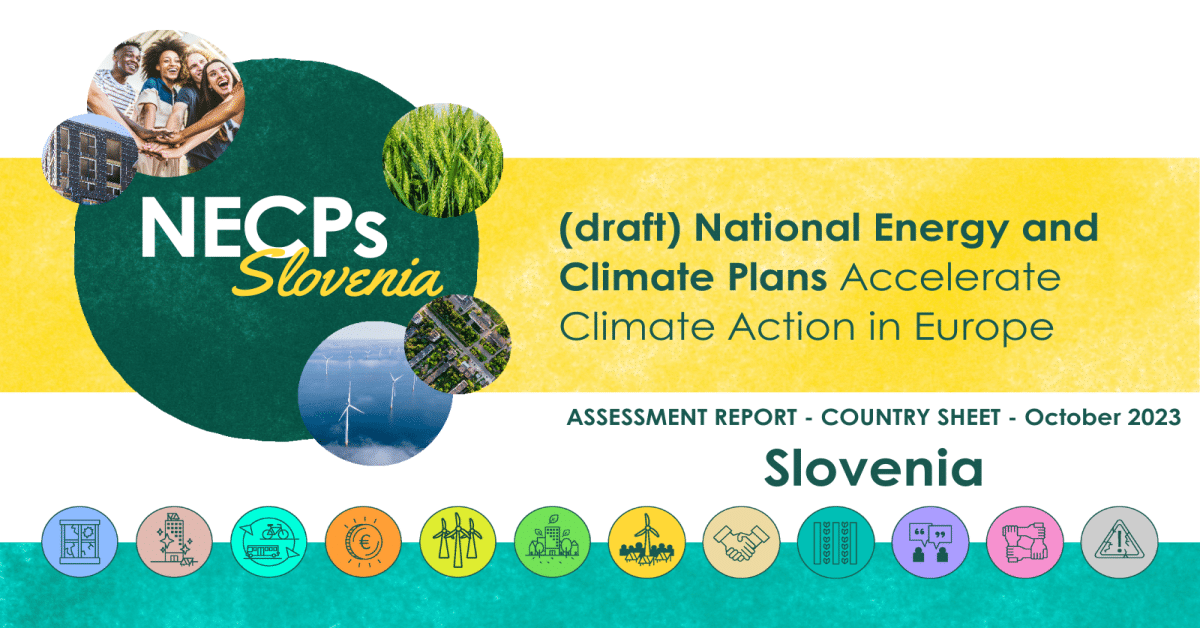The Slovenian National Energy and Climate Plan (NECP) was submitted on time. This assessment is based on the draft available on the Commission’s website. Slovenia overall does not move towards a 1.5°C trajectory. Climate targets surpass the EU minimum requirements for climate effort sharing, while both the renewable and the energy efficiency contributions are not in line with the new EU 2030 energy targets. The absence of policies and measures makes it impossible to assess their credibility.
- Increase the renewables contribution and put community energy at its core – by eliminating administrative barriers and establishing an enduring supporting mechanism;
- Plan for a substantial reduction in energy use, by including a sufficiency scenario in the draft assessing Slovenia’s capacity to reduce energy use;
- Include policies and measures, which are completely absent from the current draft.
-
Climate Ambition
Climate targets remain incompatible with a 1.5°C trajectory. The draft shows an economy-wide emissions reduction of 37-40% by 2030 (compared to 2005 levels), and a target of 55% by 2033, when coal is expected to be phased out. The draft also plans for a 2030 non-ETS target of -28-31% (compared to 2005 levels), which is higher than the one set in the unambitious Effort-Sharing Regulation (-27%). The draft also sets out to achieve climate neutrality by 2050, but projects most emissions reductions to take place only after 2030.
It is impossible to assess whether the plan will meet these targets, because the draft does not include any policies and measures (PAMs). On the other hand, if it plans the right PAMs, Slovenia certainly has the potential to raise its ambition levels, notably in the agriculture and transport sectors. For agriculture, it should focus on sustainable measures (e.g. agro-ecological practices) rather than purely technological ones; for transport, passenger transport should focus on developing public transport to move away from motorised individual transport.
Energy Transition
Slovenia sets a renewable energy contribution of 30-35 % in 2030, which will not be in line with the Governance Regulation formula benchmark to reach the binding EU 2030 renewable energy share of 42.5%. The plan should include more PAMs to accelerate newly installed solar and wind capacity. The acceleration in the installation of solar PVs on roofs should not only focus on the public sector. More measures to promote energy communities should be included, focusing on removing administrative barriers for their implementation, providing long-term stable funding and including households affected by energy poverty.
On energy savings, the level of energy consumption foreseen for 2030 amounts to 6.026 Mtoe for primary energy and 4.426 Mtoe for final energy. This is not in line with the minimum requirements of the 2023 Energy Efficiency Directive (EED) and with the 2030 EU energy efficiency target. The gap towards the required contribution as per formula benchmark in the 2023 directive for primary energy would amount to 0.24 Mtoe. The gap towards the required contribution amounts to 0.14 Mtoe for final energy as per EED formula; with a possible deviation of 2.5% the gap would still amount to 0.03 Mtoe. Additionally, the expected increase in final energy use in industry in 2030 and 2040 compared to 2020, while other sectors decrease their energy consumption, is problematic. The Slovenian draft does not indicate any policies and measures; both energy efficiency and sufficiency measures are needed to significantly reduce Slovenia’s current energy consumption levels.
FOSSIL FUELS ALERT
- Coal – Slovenia’s coal exit date is planned for 2033, while it should be by 2030 at the latest. The draft also fails to provide detailed steps for the shutdown of the TEŠ power plant, specifically the development of a legal framework is missing.
- Fossil gas – While the scenario with additional measures foresees a decrease in fossil gas consumption by 2030 compared to existing measures, the draft does not discuss any decommissioning of gas infrastructure, and actually includes several fossil gas projects of common interest in its planning.
FALSE SOLUTION ALERT
- Biogas – the draft relies too much on biogas. The final NECP update should not include incentives for expanding biogas production, but rather focus on solutions with fewer negative impacts, such as direct electrification.
IS MONEY WHERE THE MOUTH IS?
- Funding sources and investment needs are not provided for PAMs. EU funding sources are mentioned but not concretely integrated in the plan.
SNEAKY SUBSIDIES
- The NECP includes just a mere paragraph on short assessment of existing fossil fuel subsidies and does not include a clear phaseout plan, despite existing subsidies for fossil fuels in Slovenia being still high (81 million euros in 2020, based on available data).
- Refunds of excise duties on commercial diesel (for trucks and passenger vehicles), remain the most problematic (37% of incentives going against decarbonisation).
PUBLIC PARTICIPATION
- The public consultations process was satisfactory in terms of design, but civil society organisation’s recommendations were not taken into account in the final document. The online questionnaire did not provide room for questioning the document’s key assumptions.
- Multilevel dialogues do not exist.
Download slovenia country sheet NECP assessment report
Download FULL NECP assessment report
PREVIOUS
NEXT

